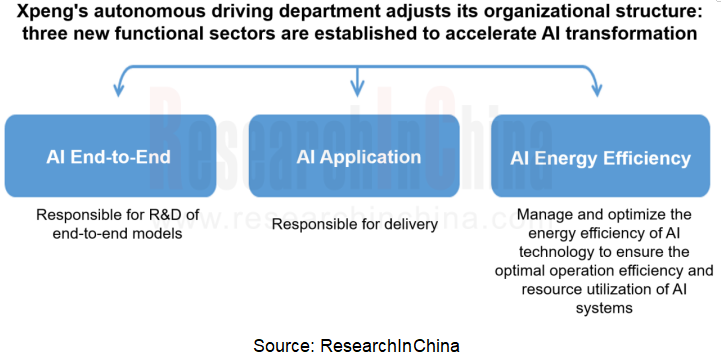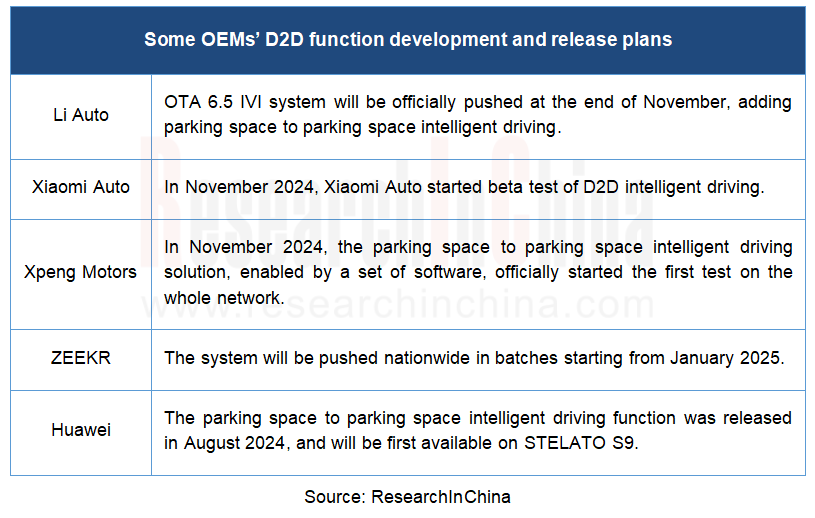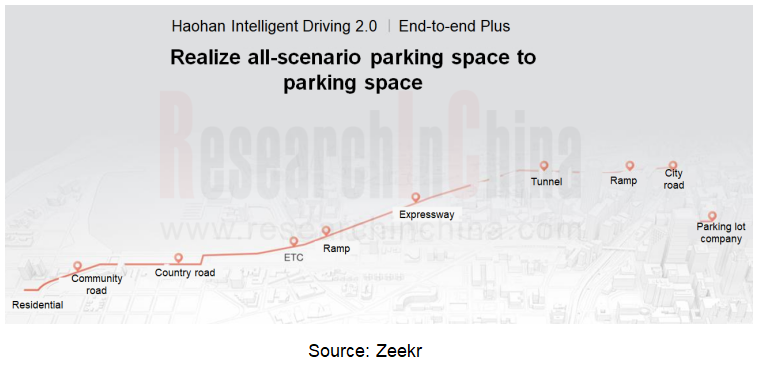OEM ADAS research: adjust structure, integrate teams, and compete in D2D, all for a leadership in intelligent driving
In recent years, China's intelligent driving market has experienced escalating technological competition in driving-parking integration, highway NOA, urban NOA, and map-free NOA. Small and medium-sized ADAS Tier1s are gradually slow to keep up with the pace of technological evolution.
Since 2024, China's ADAS and autonomous driving markets have entered an end-to-end competition. End-to-end autonomous driving requires OEMs to change their previous R&D model and invest a lot of R&D, computing power and data resources. However, multi-brand and multi-technology routes make it difficult for OEMs to pool resources to win the battle of intelligent driving. Organizational structure adjustment and team integration have become compulsory courses for domestic OEMs in 2024.
To compete in intelligent driving, OEMs keep adjusting their structure and integrating their teams
NIO continues to dynamically adjust its organizational structure to adapt to different development stages. In June 2024, NIO adjusted the organizational structure of its intelligent driving team from original perception-planning & control-execution to end-to-end autonomous driving. NIO's Intelligent Driving R&D Department has newly established the Foundation Model Department (responsible for R&D of end-to-end models), Deployment Architecture and Solution Department (responsible for vehicle-related overall algorithm development, architecture design and function delivery), and Spatiotemporal Information Department (responsible for algorithm/model development and services related to the map information on vehicle and cloud), and canceled the original Perception Department, Planning & Control Department, Environmental Information Department and Solution Delivery Department.
Xpeng has also adjusted its technology development department in 2024. Its technology development department covers R&D of algorithms for perception, planning, control, and positioning. After the adjustment, the technology development department was split into three departments: AI End-to-End, AI Application, and AI Energy Efficiency.

Around August 2024, Xiaomi Auto's intelligent driving team also completed a new round of organizational structure adjustments, mainly combining the two secondary departments of "Perception" and "Planning & Control" and reorganizing them into the "End-to-End Algorithm and Function Department."
Not only are emerging OEMs constantly adjusting their organizational structures, but also traditional OEMs are making a rapid change.
In June 2024, BYD set up the Tianxuan Development Department for developing intelligent driving in house. It is positioned to self-develop high-level intelligent driving solutions. BYD also established the Tianlang Development Department, positioned to develop low-level intelligent driving solutions. In the second half of 2024, BYD deeply integrated its organizational structure. The core members of the original "Tianxuan" team have been incorporated into the "Tianlang" self-development team.
"Parking space to parking space” (D2D) will become the focus of competition among OEMs in 2025
Following Huawei that introduced parking space to parking space intelligent driving in August this year, Li Auto, Xpeng and Xiaomi among others will also implement high-level intelligent driving from parking space to parking space.
Xpeng Motors says: Based on the Xpeng Turing AI Intelligent Driving System, Xpeng has become a company that can enable the parking space to parking space function using a set of intelligent driving software and end-to-end foundation models. The solution adopts a set of software logics to connect scenarios such as underground garages, gates, and urban roads. It also lays less stress on maps and radars, and can generate routes unconsciously. Xpeng Motors announced the launch of the first full network test at the Auto Guangzhou, and will push it in full on AI Dimensity 5.5.0 in the future.
As well at the Auto Beijing, Fan Haoyu, Senior Vice President of Li Auto's Product Department, said that the parking space to parking space function based on end-to-end + VLM has been pushed to 10,000 beta test users, and test drive cars of outlets, across the country. In late November, all AD Max users can enjoy D2D supervised intelligent driving.

On November 16, Xiaomi Auto announced on its WeChat official account: the official name of its parking space to parking space function is All-scenario Intelligent Driving. This function enables parking space to parking space driving assistance as the user gets in the car. All-scenario Intelligent Driving will be installed in Xiaomi HAD (Hyper Autonomous Driving). In the future, Xiaomi SU7 Pro, Xiaomi SU7 Max, and Xiaomi SU7 Ultra models can all be upgraded with this function.
In November 2024, Zeekr released the Haohan Intelligent Driving 2.0, which will soon enable D2D intelligent driving. The D2D function launched by Zeekr has three core highlights: full-speed activation, all-gate access, and all-scenario intelligent parking not limiting parking spaces. It is the industry’s first to realize automated parking without memorizing the road in advance, creating a caring parking space-to-parking space service for users. This function is expected to be pushed in batches in January 2025, and will be fully pushed nationwide to all Zeekr products equipped with Haohan Intelligent Driving 2.0 in Q2 2025.

How long can emerging OEMs self-developing intelligent driving maintain their lead?
Looking at OEMs’ development course of intelligent driving in past few years, emerging OEMs are undoubtedly successful and have always been the leaders. However, Huawei, DJI, MOMENTA and other leading Tier1s do not lag behind. The state-of-the-art all-scenario parking space-to-parking space intelligent driving function in 2024 is first launched on BAIC STELATO S9.
Li Auto has made great progress in intelligent driving in 2024 by relying on its huge user base and rapid entry into end-to-end. Chinese OEMs such as BYD, Chery, SAIC, and Geely, with much more sales, are also expected to change the pattern in 2025 with the support of leading intelligent driving Tier1s.
In addition to traditional Chinese OEMs, there are also foreign OEMs. On November 14, at its 2024 Technology Innovation Day event, Mercedes-Benz introduced a new “map-free L2++ all-scenario high-level intelligent driving function based on vision-only solution”. This high-level intelligent driving system adopts a vision-only solution and NVIDIA DRIVE Orin chip, does not rely on HD maps, uses end-to-end foundation models, and can achieve perception-decision integration. In the future, it will have point-to-point all-scenario intelligent driving capabilities (i.e. parking space to parking space intelligent driving capabilities) from pulling out of the starting parking space to pulling in the destination parking space.
This intelligent driving system of Mercedes-Benz was developed with the support of MOMENTA, a leading intelligent driving Tier1. As multinational OEMs such as Mercedes-Benz, Toyota, and Volkswagen learn to introduce Chinese intelligent supply chains, they also equip their cars with cutting-edge intelligent driving and cockpit functions. Market competition will become fiercer in 2025. A former leader may not always be the leader.
Autonomous Driving Domain Controller and Central Computing Unit (CCU) Industry Report, 2025
Research on Autonomous Driving Domain Controllers: Monthly Penetration Rate Exceeded 30% for the First Time, and 700T+ Ultrahigh-compute Domain Controller Products Are Rapidly Installed in Vehicles
L...
China Automotive Lighting and Ambient Lighting System Research Report, 2025
Automotive Lighting System Research: In 2025H1, Autonomous Driving System (ADS) Marker Lamps Saw an 11-Fold Year-on-Year Growth and the Installation Rate of Automotive LED Lighting Approached 90...
Ecological Domain and Automotive Hardware Expansion Research Report, 2025
ResearchInChina has released the Ecological Domain and Automotive Hardware Expansion Research Report, 2025, which delves into the application of various automotive extended hardware, supplier ecologic...
Automotive Seating Innovation Technology Trend Research Report, 2025
Automotive Seating Research: With Popularization of Comfort Functions, How to Properly "Stack Functions" for Seating?
This report studies the status quo of seating technologies and functions in aspe...
Research Report on Chinese Suppliers’ Overseas Layout of Intelligent Driving, 2025
Research on Overseas Layout of Intelligent Driving: There Are Multiple Challenges in Overseas Layout, and Light-Asset Cooperation with Foreign Suppliers Emerges as the Optimal Solution at Present
20...
High-Voltage Power Supply in New Energy Vehicle (BMS, BDU, Relay, Integrated Battery Box) Research Report, 2025
The high-voltage power supply system is a core component of new energy vehicles. The battery pack serves as the central energy source, with the capacity of power battery affecting the vehicle's range,...
Automotive Radio Frequency System-on-Chip (RF SoC) and Module Research Report, 2025
Automotive RF SoC Research: The Pace of Introducing "Nerve Endings" such as UWB, NTN Satellite Communication, NearLink, and WIFI into Intelligent Vehicles Quickens
RF SoC (Radio Frequency Syst...
Automotive Power Management ICs and Signal Chain Chips Industry Research Report, 2025
Analog chips are used to process continuous analog signals from the natural world, such as light, sound, electricity/magnetism, position/speed/acceleration, and temperature. They are mainly composed o...
Global and China Electronic Rearview Mirror Industry Report, 2025
Based on the installation location, electronic rearview mirrors can be divided into electronic interior rearview mirrors (i.e., streaming media rearview mirrors) and electronic exterior rearview mirro...
Intelligent Cockpit Tier 1 Supplier Research Report, 2025 (Chinese Companies)
Intelligent Cockpit Tier1 Suppliers Research: Emerging AI Cockpit Products Fuel Layout of Full-Scenario Cockpit Ecosystem
This report mainly analyzes the current layout, innovative products, and deve...
Next-generation Central and Zonal Communication Network Topology and Chip Industry Research Report, 2025
The automotive E/E architecture is evolving towards a "central computing + zonal control" architecture, where the central computing platform is responsible for high-computing-power tasks, and zonal co...
Vehicle-road-cloud Integration and C-V2X Industry Research Report, 2025
Vehicle-side C-V2X Application Scenarios: Transition from R16 to R17, Providing a Communication Base for High-level Autonomous Driving, with the C-V2X On-board Explosion Period Approaching
In 2024, t...
Intelligent Cockpit Patent Analysis Report, 2025
Patent Trend: Three Major Directions of Intelligent Cockpits in 2025
This report explores the development trends of cutting-edge intelligent cockpits from the perspective of patents. The research sco...
Smart Car Information Security (Cybersecurity and Data Security) Research Report, 2025
Research on Automotive Information Security: AI Fusion Intelligent Protection and Ecological Collaboration Ensure Cybersecurity and Data Security
At present, what are the security risks faced by inte...
New Energy Vehicle 800-1000V High-Voltage Architecture and Supply Chain Research Report, 2025
Research on 800-1000V Architecture: to be installed in over 7 million vehicles in 2030, marking the arrival of the era of full-domain high voltage and megawatt supercharging.
In 2025, the 800-1000V h...
Foreign Tier 1 ADAS Suppliers Industry Research Report 2025
Research on Overseas Tier 1 ADAS Suppliers: Three Paths for Foreign Enterprises to Transfer to NOA
Foreign Tier 1 ADAS suppliers are obviously lagging behind in the field of NOA.
In 2024, Aptiv (2.6...
VLA Large Model Applications in Automotive and Robotics Research Report, 2025
ResearchInChina releases "VLA Large Model Applications in Automotive and Robotics Research Report, 2025": The report summarizes and analyzes the technical origin, development stages, application cases...
OEMs’ Next-generation In-vehicle Infotainment (IVI) System Trends Report, 2025
ResearchInChina releases the "OEMs’ Next-generation In-vehicle Infotainment (IVI) System Trends Report, 2025", which sorts out iterative development context of mainstream automakers in terms of infota...